BACK TO EXHIBITS
Mary Gasperik Quilters Hall of Fame Induction Exhibit
The “Heritage” designation indicates that Mary’s work was accomplished 80 or more years ago.
The Quilters Hall of Fame Induction is a weekend-long celebration. Events begin on Thursday with lectures, quilt shows, vendors, and exhibits of the work of the honorees. (The other honoree in 2021 was Marti Michell, teacher, designer and proprietor of Yours Truly.) Venues include the Marion Public Library, The Masonic Building, and The Quilters Hall of Fame (Marie Webster House). All activities continued on Friday including the Anna Harkins lecture, More is More: Meet Mary Gasperik and Beth Donaldson, The Quilt Index Honors Mary Gasperik. There was also a Gasperik family luncheon at the Hostess House where grandchildren, great-grandchildren, and great-great-grandchildren had a family reunion.
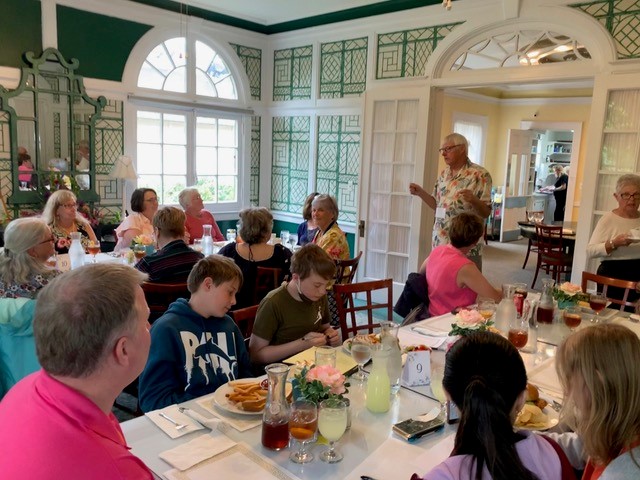
Members of the Gasperik family and quilt researchers listen to QHF Board Member John Divine welcome everyone to the Gasperik induction weekend.
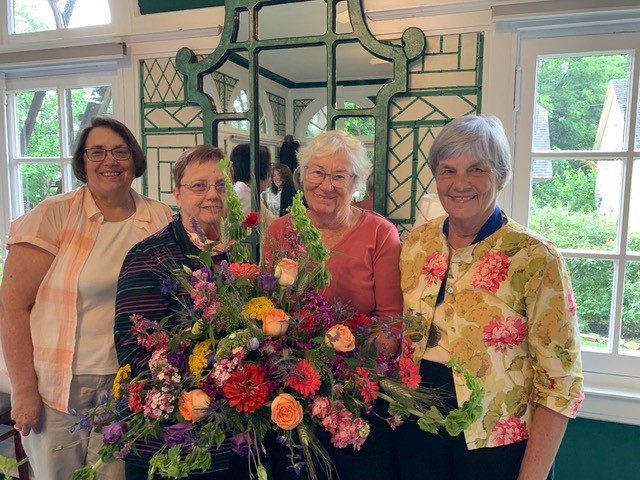
Left to right: Beth Donaldson, Anna Harkins, Susan Salser, and Merikay Waldvogel at the Gasperik family reunion luncheon. The flowers were a gift from Merikay Waldvogel. When Merikay was inducted to the QOF in 2009, Susan gave her a beautiful bouquet of flowers inspired by the Indiana Wreath quilt pattern. When Mary Gasperik was inducted, Merikay returned the gesture with a bouquet of Indiana Wreath flowers for Susan Salser.

Susan Salser during the Induction Ceremony.
A lecture originally delivered by Susan Salser on July 17th, 2021 at the Quilter's Hall of Fame induction of Mary Gasperik, in Marion Indiana. Reenacted and recorded August 15th 2021 with Merikay Waldvogel, Kathy Jacob, and Cathy Salser.

Merikay Waldvogel speaks about Colonial Quilting Bee during the exhibit walk-thru.

Gasperik family members during the Induction Ceremony.

Gasperik Family Tree made by Mary's great-great-grandson Sam Salser-Meyers and family.
The Quilts
Indiana Wreath quilts, including those made by Quilters Hall of Fame Honoree Rose Kretsinger are based on the 1850s Indiana Wreath appliqué quilt which appeared in color in Quilts: Their Story and How to Make Them by Hall of Fame Honoree Marie Webster. The Indiana Wreath pattern #524 was offered in McCall's Needlework Magazine, Winter 1937-1938, and Mary Gasperik probably consulted this pattern when she designed her Indiana Wreath quilts. She added the group of bluebirds, and included wheat, a favored Hungarian motif, to the floral spray.
The four Gasperik Indiana Wreath quilts, #032, #063 , #011, #043, can be divided into two sets of two (#032 & #063 and #011 & #043). Each pair uses the same set of fabrics.
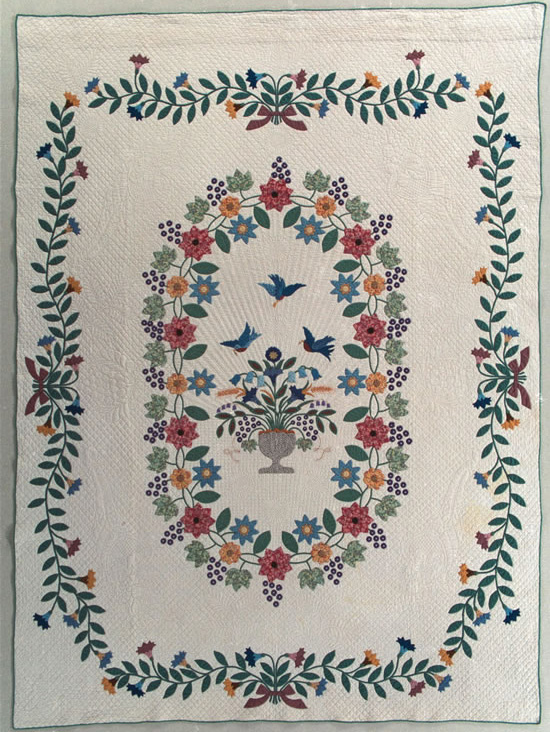
1. Indiana Wreath #032 (cream back, nothing under vase)
c1940
Generously loaned by Linda MacLachlan
This quilt pairs with the one hanging opposite, #063. Because a quilting motif which was offered in 1943 by Woman's Day (May 1943, p.42; the pattern was sold as 'Coat of Arms' by the magazine) does not appear on this quilt although it does appear on the three other Gasperik Indiana Wreath quilts, it is thought that this was the first of the four Gasperik Indiana Wreath quilts to be completed. That the quilting on this quilt is somewhat less complex than the quilting on the other three quilts might substantiate this hypothesis.

2. Indiana Wreath #011 (cream back, images under vase)
1938-1945
Loaned with love by Kathy Jacob
This quilt and its partner (not displayed because of fading) use a set of polka dots prints of different colors and also have wheat stalks embroidered under the vase. This quilt won a blue ribbon at the 1953 Illinois State Fair, and its partner won the same prize there in 1958.

3. Indiana Wreath #063, (green back)
1940s, possibly 1950s
raciously loaned by Karen Finn
f the four Gasperik Indiana Wreath quilts, only this one has a distinctive lime green backing, which might date it to the early 1950s rather than the 1940s. It has an extra layer of batting to give dimension to the grapes which are made from a print of white stars on dark purple, cut such that the effect is of water glistening on a rounded surface. The most significant of the motifs Gasperik quilted in her versions of Indiana Wreath are the grape cluster and the elaborate corner feather design which she borrowed from Romance of the Patchwork Quilt in America written by Hall of Fame Honoree Rose Kretsinger. With her re-creations of the famous Indiana Wreath, Gasperik was saluting Webster and Kretsinger, two major quilt figures of her time.

4. What Are Little Boys Made Of?/Andy’s Quilt
1957
Graciously loaned by Karen Finn
This quilt was made for Mary’s first great-grandson, Andy Finn in honor of his birth. The boys’ clothing has real pockets and buttons. The quilting in the top half of the quilt resembles Gasperik's Indiana Wreaths, including the large elaborate quilted cornucopias spilling fruit and flowers as well as the embedded feathered heart and feathered wreaths. In the lower half of the quilt relates to the fisher-boy with sailboats and fish embedded in a wave pattern.

4a. This was displayed as a poster.
Four Little Pigs
38 x 42. 1936
Graciously loaned by Karen Finn
Made in anticipation of her first grandchild, this quilt is “embellished” by the addition of a girl pig dancing with the traditional story-tale three little boy pigs. Perhaps Mary was hoping for a girl. Karen Kruger was born in the same year as the quilt was completed, but since there were no ultrasounds then, the sex of the unborn baby could only have been wished for. Another explanation is that the pigs represent Mary’s children, Steven, Elmer, Edward (who died in infancy) and Elsie.
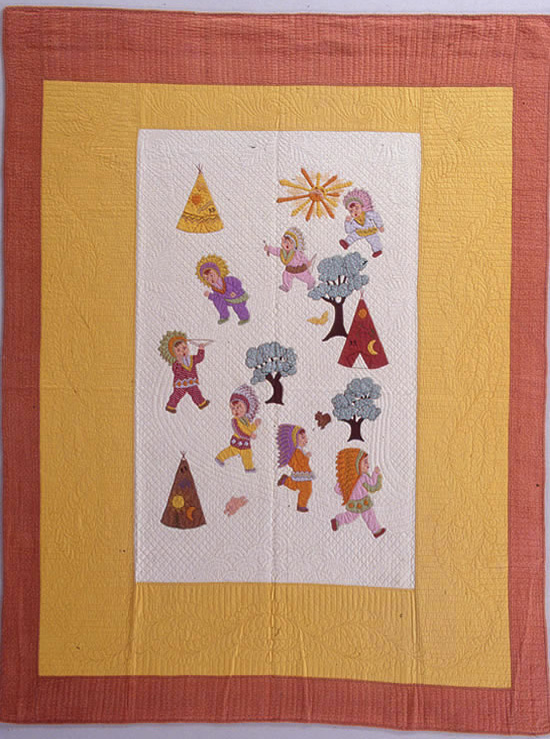
5. Indian Boys/ Seven Little Indians #5
c1940
Proudly loaned by Robert Gasperik
In the 1940s, Gasperik made six Indians quilts for her Chicago grandchildren (#056, #028, #039, #019, #077, #076), and another she sent to relatives in Hungary. The three quilts made for her grandsons Michael, David and Robert have an extra border, which their mother probably requested to fit their beds. This is Robert's quilt. Like all Gasperik quilts, it employs elaborate quilting including cable feathering and cornucopias spilling fern leaves.

6. Nursery Rhymes
1935-1945
Loaned with love by Kathy Jacob
This is Gasperik's refashioning of a Homeneedlecraft Creations kit. The printed kit number (No 7145 CRIB QUILT) is partially visible at a point where she chose to quilt a design where an appliqué and embroidered image was originally placed. Mary completely altered the overall quilting pattern stamped on the quilt-top, stitching a denser grid, adding an embedded elaborately quilted feathered wreath as well as quilted hearts. She finished off the kit's edge with a quilted border of feathering and attached two additional, wide fabric borders, one in a delicate yellow flowered print and the other in solid gold with scalloped outer edge and interior overlapping arches of quilting. She often made multiple borders a prominent design feature of her quilts, creating large expanses of especially fine quilting. She transformed a fairly plain kit into a distinctively Gasperik quilt.
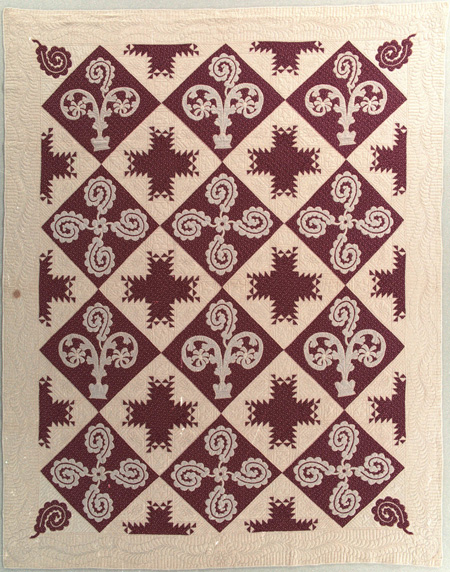
7. Burgundy Double Feathered Star
1937
Loaned with love by Kathy Jacob
Mary Gasperik's quilts are unique in that she often combined ideas and patterns which she gathered from a multitude of sources. In this case, she used a photo from Marie Webster’s book Quilts: Their Story and How to Make Them, to which she added a commercial quilting design. This quilt may have been made to compete in the Detroit News Quilt Show, where it was exhibited in 1937 along with the note below. The Gasperik Double Feather Star quilts (#045, #081) and the Webster Feather Star with Applique quilt are composed of three different block designs: a pieced feathered star block, an appliquéd quadruple plume block, and an appliqued triple plume set in a vase.
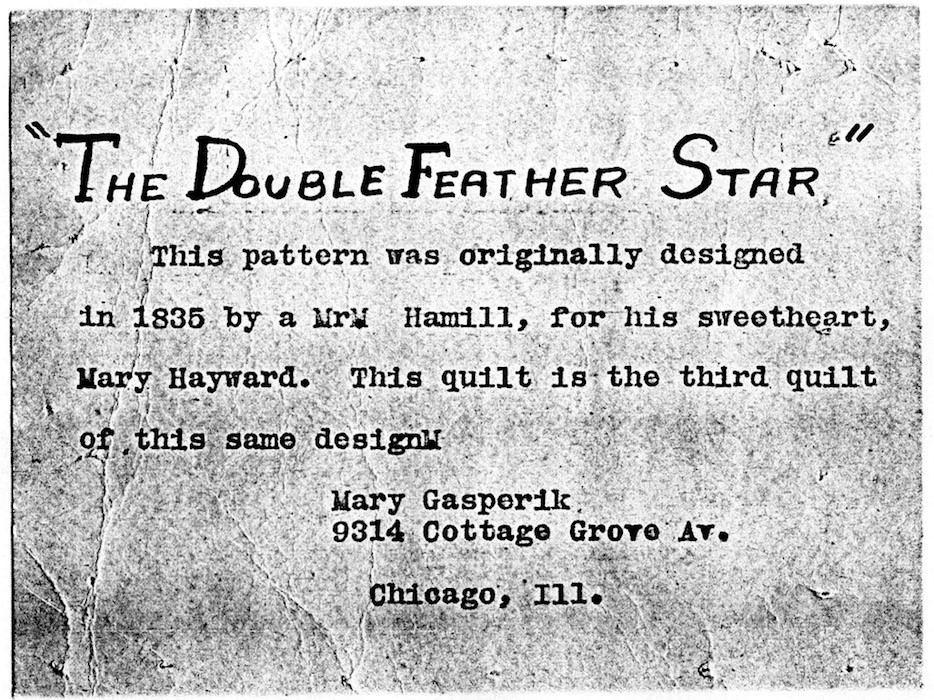
Tag thought to be from a Detroit News Quilt show.

8. Indian Double Feathered Star
1936
Generously loaned by Linda MacLachlan
Although the Gasperik Indian Feather Star is inspired by a different Marie Webster antique quilt photograph, it in fact uses the same feather star block pattern. It was difficult to translate that Webster quilt into a useable pattern, and her travails were shared a Detroit News quilt column published in The Detroit News, February 11, 1936. Even the title of this column (“there are 1467 Pieces in This charming Top”), captures the complexity of the pattern painstakingly created from that small Webster photograph.

9. Delectable Mountains
1953
Proudly loaned by Robert Gasperik
This Delectable Mountains quilt is a close copy of the quilt that won 3rd place at the 1933 Sears Quilt Contest. A photo of the quilt also appeared in the instructional booklet used by Mary Gasperik at Tuley Park Quilting Club. This quilt shows how Mary got creative with published designs: it has an unusual number of pieced patterns and an array of quilting motifs, including black birds which are part of the coat of arms of Gasperik’s Hungarian birth city, Hodmesovasharheli.

10. Apricot Morning Glory
c1940
Generously loaned by Linda MacLachlan
This is one of two Apricot Morning Glory quilts made by Gasperik. The quilting on the two quilts is slightly different and there are fewer green leaves appliquéd into the wreath on this quilt than on its twin (#062). This quilt won a blue ribbon at an Illinois State Fair in 1941. Mary also made two blue Morning Glory quilts (#016, #009). Her starting point was probably a Bucilla kit, but on all four quilts, she softened the shades, limited her palette, and tinkered with the arrangement of the leaves.

11. Daisies Won’t Tell
1940-1946
Graciously loaned by Susan Salser
This quilt, with an overall layout is similar to Hall of Fame Honoree Mary A. McElwain’s pattern Daisy Chain, won second prize at the 1942 Indiana State Fair and a blue ribbon at the August 1946 Illinois State Fair. Gasperik modified the design with a heart-shaped center replacing the original published oval, and added other creative touches.

12. Rose Wreaths/Roses and Forget-Me-Nots
1938
Loaned with love by Kathy Jacob
This quilt competed in the 1938 Detroit News Quilt Contest where it may have been awarded the prize for best appliqué made from a News pattern, the highest award Gasperik won in Detroit. She closely followed the Detroit News appliqué pattern for Roses and Forget-Me-Nots, but some of the quilting designs and the scalloped edge were her own choices. She chose spiders’ webs, rather than lattice patterns to quilt inside the appliquéd wreaths and added an additional 24 spiders’ webs in the spaces connecting all of the wreaths. For her border, Gasperik created an elaborate sunburst design which she quilted into each scallop (creating the look of a swag border through quilting alone) and filled the narrow pink outer border with feather quilting.

13. Star Arcturus
1934
Graciously loaned by Susan Salser
We know Mary Gasperik was inspired by quilts at the Century of Progress Exposition (the Chicago World's Fair), and this quilt honors that event. The rocket and star pattern named Star Arcturus refers to the distant star 40 light years away. Fair officials reminded Chicagoans that the light coming from the star began its journey in 1893 when Chicago's first world's fair was held. Light transmitted from the star Arcturus was not only used to illuminate the opening of the fair, it was used to turn on the exposition's myriad lights each night. The star became a World's Fair logo adorning many souvenirs. The basic block is a Nancy Capot design, but Mary made it her own through her color choice, and the addition of satellite stars and the grinning moons in the corners.

14. Bridal Bouquet
1956
Graciously loaned by Karen Finn
Mary Gasperik pulled out all her best quilting motifs for this quilt made in honor of her granddaughter Karen’s wedding. The designs include wedding bells, double roses, fern leaves both as separate triplets and spilling from small cornucopias, large complex feathers extending from a pineapple pattern centered at the bottom of the pink gingham medallion. There is also a tulip triplet which is similar to the appliqué pattern she used on a prize-winning bolero. Mary also painstakingly quilted the cross-checks of the entire pink gingham background. The calla lily appliqué in the center appears on all the quilts Gasperik made for weddings. This quilt won a blue ribbon at the 1957 Illinois State Fair.

15. Bridal Bouquet
Elmer and Doris Wedding quilt 1944
Loaned with love by Kathy Jacob
In this 1944 wedding quilt Gasperik tapped multiple sources to create an original design. She transposed a Detroit News quilting motif into an appliqué calla lily at the bouquet's center. Other appliquéd floral designs in the bouquet may have come from Nancy Cabot/Chicago Tribune. The ribbons streaming from the bouquet are reminiscent of those on traditional Hungarian bridal headwear. A similar bridesmaid also appears on the wedding quilt (#074) made for her great-niece Mary Bruland in the 1930s.

16. Double Trunk Tree of Life
1942
Graciously loaned by Karen Finn
This is the most elaborate of the five Tree of Life Quilts (#031, #044, #082, #083), showing the greatest degree of transformation of a 1934 McCall pattern and including elements from outside sources. The blue birds wear embroidered crowns which didn’t appear on earlier versions. Two of the oak leaves on the lower branch appear to be left-overs from Gasperik's 1939 quilt Road to Recovery.

17. Burgundy Leaf and Vine
1940
Generously loaned by Joanne Gasperik
Unusual for a Gasperik quilt, the Burgundy Leaf and Vine has a limited palette. Gasperik adapted a commercial kit when she made three versions of her Leaf and Vine (#061 is not on display) quilt. Each one has a signature appliqué motif; here it’s a split laurel wreath. There is an elaborate quilted basket of flowers and fruit at the quilt center.

18. Pink Leaf and Vine
1944
Loaned with love by Kathy Jacob
This quilt was made for the 1944 wedding anniversary of Mary’s son and his wife--Elmer and Doris Gasperik. The palette of this quilt is less formal than on the burgundy version. In honor of the occasion, it has wedding bells as part of the quilting design. The appliqué motif that differentiates this quilt from the other two versions of the same pattern is the Lily Bouquet from the Detroit News that Gasperik used as a quilting pattern on the wedding quilt she made for the couple.

19. Laurel Wreath
1935
Graciously loaned by Karen Finn
The Nancy Page Quilt Club Laurel Wreath was offered, by a number of different newspapers in 1934-1935, as a series of 28 separate patterns published consecutively (usually one a week). Gasperik put her own touches on the pattern by using only 12 of the Nancy Page blocks, limiting the number of laurel wreaths and filling in with appliqué flowers whose patterns are not Nancy Page patterns. This quilt was displayed at a Tuley Park (Mary’s local quilting group) show.

20. Hosannah
1941
Loaned with love by Kathy Jacob
Gasperik created a pieced quilt based on a traditional pattern block, which she might have found in a number of publications at the time. The alternating plain blocks and the wide green border provided areas for her favored quilting motifs--the Dove of Peace and the fern leaf designs. It is likely Gasperik undertook this particular quilt project when Hall of Fame Honoree Bertha Stenge’s Palm Leaf quilt won national acclaim.

21. Colonial Quilting Bee
1935-40
Generously loaned by Linda MacLachlan
This masterpiece quilt has many connections to the Detroit News Quilting Corner column and related quilt shows. The seated quilter motif was used as a logo on registration forms and announcements, and the central layout of quilters around a frame likely came from a quilt by a Mrs. Miller which was on display in 1935, the first Detroit quilt show Gasperik attended. But as usual, Mary brought her own creativity to her version: she changed the orientation of the quilters, made to facing forward and sewing flags rather than quilts (one US and one Hungarian), and substituted an elaborate star pattern quilt for the miniature crazy quilt in the center of the Miller quilt. And Mary put herself into the quilt by having one of the quilters working on what looks like her own Star Arcturus quilt. This quilt was exhibited for a year at the Smithsonian Institution.

22. Hungarian Harvest Festival/Hungarian Girls
1938
Loaned with love by Kathy Jacob
Of all the quilts made by Mary Gasperik, this one is the all-time favorite of many family members. It salutes Mary's Hungarian heritage. She called it her "Magyar qvilt". The exquisite embroidery skills so well displayed on this quilt are a part of Mary's Hungarian heritage applied to a new medium, the American quilt. This quilt also has connections to the Detroit News: in 1938 Mary shared the design of the girls with Quilting Corner editor Edith B. Crumb who invited members to give it a try. Then Mary used the design to create this full-sized quilt which took an Honorable Mention ribbon in the 1940 Detroit News show. The quilt also won blue ribbons at the Illinois State Fair in 1940, 1947, 1960, and 1966.
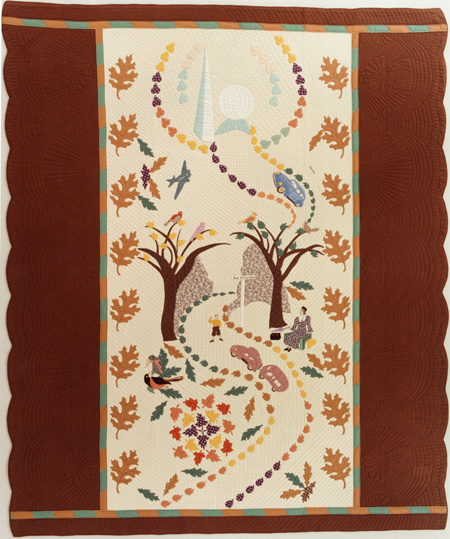
23. Road to Recovery
1939
Graciously loaned by Karen Finn
This is Mary Gasperik's original design to commemorate the 1939 New York World's Fair; it was made for a quilt contest "Better Living in the World of Tomorrow." Through her quilt, Gasperik interpreted the 1930s era as a journey along a roadway from depression to hope and then recovery. The journey's end is depicted by the Trylon and Perisphere, symbols of the 1939 New York World's Fair. Mary Gasperik wrote her thoughts about her original design in Hungarian, "This dear old lady is trying to bear the trials of poverty inflected upon her by the depression, and in passing along with the years, she must stop and rest to gather fresh courage to reach the 'World of Tomorrow.' Heedless of the traffic, only one thought persists in her mind, to attain her goal. The autumn leaves represent the poverty of the depression as it touched humanity. The birds are singing songs of encouragement. Beyond those mountains lies Recovery, the New York World's Fair of 1939."
(Translated by daughter Elsie Krueger).
Lois Levihn wrote about Gasperik's exhibit in her "Around the Frame" column on August 13, 2021 for the Waynedale News, https://quiltindex.org/view/?type=publications&kid=18-121-724.
-
Legacy
Gasperik Legacy Project, Mary -
Quiltmaker
Gasperik, Mary Mary Gasperik Legacy Project
-
Essay
Mary Gasperik (1888-1969): Her Lif...
Waldvogel, Merikay
-
Essay
American Quilts Empowered Immigrant Wo...
Salser, Susan
-
Essay
Mary Gasperik and the Tuley Park Quilt...
Waldvogel, Merikay
-
Essay
Mary Gasperik and the Detroit...
Salser, Susan
-
Gallery
Gasperik 01: Masterpiece Quilts
Waldvogel, Merikay
-
Gallery
Gasperik 02: Antique Quilt Design Sour...
Waldvogel, Merikay
-
Gallery
Gasperik 03: 1930s Quilt Pattern Sourc...
Waldvogel, Merikay
-
Gallery
Gasperik 04: Kit Quilts
Waldvogel, Merikay
-
Gallery
Gasperik 05: Gifts for Children
Waldvogel, Merikay
-
Gallery
Gasperik 06: Gifts for Weddings & ...
Waldvogel, Merikay
-
Gallery
Gasperik 07: Appliquéd Blo...
Waldvogel, Merikay
-
Gallery
Gasperik 08: Mystery Quilts - Unidenti...
Waldvogel, Merikay
-
Gallery
Gasperik 09: Wholecloth Quilts
Waldvogel, Merikay
-
Gallery
Gasperik 10: Practical Quilts
Waldvogel, Merikay
-
Story
Mary Gasperik's Road to Recove...
Salser, Susan
-
Exhibit
The Quilts of Mary Gasperik
Salser, Susan
-
Ephemera
Celebration 2021 - The Quilters Hall o...
Quilters Hall of Fame
-
Ephemera
Womenfolk 08. Depression Era Quilts: C...
Breneman, Judy Anne
-
1938-1945
Indiana Wreath Gasperik, Mary
-
1938-1945
Indiana Wreath Gasperik, Mary
-
1940s
Indiana Wreath Gasperik, Mary
-
1957
What Are Little B... Gasperik, Mary
-
1936
Four Little Pigs Gasperik, Mary
-
1954
Indians #5 Gasperik, Mary
-
1935-1945
Nursery Rhymes Gasperik, Mary
-
1937 circa
Double Feather St... Gasperik, Mary
-
1935-1950
Indian Feather St... Gasperik, Mary
-
1950s
Delectable Mounta... Gasperik, Mary
-
1938-1945
Morning Glory Gasperik, Mary
-
1940-1946
Daisies Won't Tel... Gasperik, Mary
-
1938
Roses and Forget ... Gasperik, Mary
-
1934
Star Arcturus-Cen... Gasperik, Mary
-
1956
Bridal Bouquet Gasperik, Mary
-
1944
Bridal Bouquet Gasperik, Mary
-
1938
Tree of Life Gasperik, Mary
-
1940s
Leaf and Vine Gasperik, Mary
-
1944
Leaf and Vine Gasperik, Mary
-
1935
Laurel Wreath Gasperik, Mary
-
1941
Hosannah Gasperik, Mary
-
1935-1940
Colonial Quilting... Gasperik, Mary
-
1938-1940
Hungarian Harvest... Gasperik, Mary
-
1939
Road to Recovery Gasperik, Mary
Load More